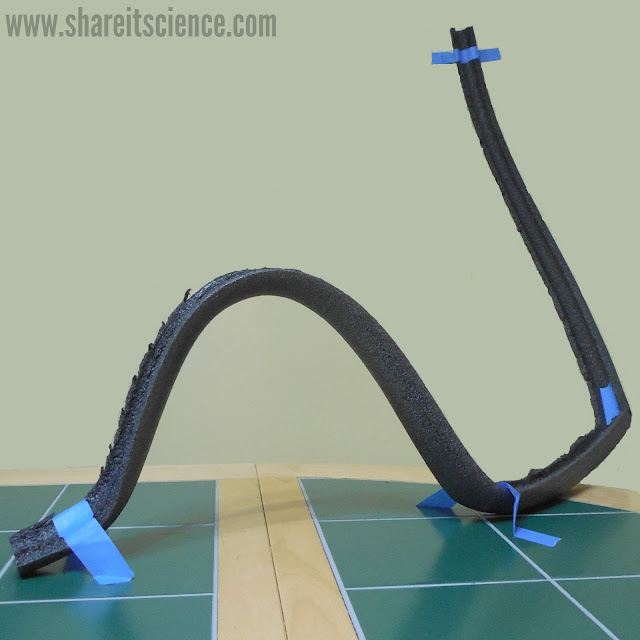In this post we'll explore Gravity is a Mystery and the concept of gravity with a hands-on science and engineering investigation: marble roller coasters. You'll also find a free printable "Weight in Outer Space" worksheet and a list of further resources for teaching and learning about gravity. This post is part of the Let's-Read-And-Find-Out Science® Series hosted by My Joy-Filled Life blog.
This post contains affiliate links, meaning I will receive a small commission (at no additional cost to you) if you make a purchase after clicking a product link. Please see disclosures page for more details.
Let's-Read-And-Find-Out Science®: Gravity is a Mystery
If you haven't read a Let's-Read-And-Find-Out Science book before, you are missing out. Written by many authors well versed in the fields of science and science for kids, they are books that are written in kid-friendly language, have engaging illustrations, and often include activity ideas and background information.
The books come in 2 stages, stage 1 stories are books about simple concepts appropriate for preschool and kindergarten, stage 2 books explore more difficult concepts for elementary aged kids.
Gravity is a Mystery is a stage 2 book. In it, a scientist and his dog explore the mysterious force of gravity. It answers interesting questions like: What would happen if you dug a hole through the center of the Earth and jumped in? How does gravity pull on you and other objects? How does gravity work? What does weight have to do with gravity? Why do we weigh different amounts on different planets?

Gravity is a Mystery is an excellent launching point for science activities about gravity. Read on to learn how to build a marble roller coaster and calculate your weight on other planets. If you are looking for even more activities about gravity and forces, check out these gravity lesson ideas.
Build a Marble Roller Coaster
Building and designing marble roller coasters is an engaging STEM activity for just about any age. I have done this activity in the classroom and during family science night programs and it is always a hit with kids and adults.
What do roller coasters have to do with gravity? Once a roller coaster is pulled up the "lift hill" by a motor and released, the rest of the ride is controlled by the force of gravity, and inertia, or the tendency of a moving object to maintain its forward velocity. Thanks to gravity and inertia, a roller coaster can stay on its tracks as it spins and flips.
You will need:
- Marbles
- 3/8" Foam pipe insulation
- Utility knife
- Painter's tape (blue tape)
Build the Roller Coaster
First, you'll need to prepare the foam insulation. Although you can build roller coasters out of many different types of material, I like this way best. Use the utility knife to carefully slice down the solid side of the pipe insulation.The foam is flexible and can be used over and over again. It is already split down one side to fit around the pipe, so by simply slicing down the opposite side, you can make 2 troughs that a marble fits perfectly inside of.
Although you can use any type of tape, I suggest using painter's tape because it allows you to attach the roller coasters to most surfaces without damaging them. This way you can work across the wall, floor, tables and chairs. It also peels nicely off of the foam insulation, so you can re-use the pieces.
Start out by encouraging kids to build a simple design while they get the hang of how the marble will behave in the roller coaster. Expect to use a lot of tape during the design process!
Once they've experimented through trial and error, add some more complex elements to the coaster. Challenge them to include hills, a loop-the-loop, a spiral or some other spine-tingling roller coaster element.
Other Ways to Build a Marble Roller Coaster
If you want to continue exploring the idea of roller coasters, you can also build them with recycled materials like we did here for our Family STEAM Night event.
You also will want to check out this really neat set of marble tracks for home or the classroom. I love how it lends itself to open-ended exploration, it won a toy of the year award in 2016 and is reasonably priced. Learning through FUN is the best!

It would be super fun to have this on the refrigerator, wouldn't it? STEM and a snack!
Gravity and Weight in Space
The weight of an object is equivalent to how much the force of gravity is pulling the object towards the Earth. The strength of this force changes with mass and distance. The larger an object is, the greater the force of gravity. This is why the force of gravity from the Sun, which is enormous compared to the planets, can hold all the planets in orbit. Gravity is also stronger when the distance between the objects is smaller. This is why the planets are not pulled away from our Sun, toward another, further away massive star.
This relationship is also what would make us weigh different amounts on different planets. You've probably had some experience with this concept at a science museum or planetarium. You can calculate the weight of an object, or yourself, on a different planet. The closer the planet is in size to Earth, the closer your weight will be to your weight on Earth.
Use this free "Weight in Outer Space" printable worksheet to explore this concept with kids. It requires multiplication, so is best for upper elementary and above. Please note that I have chosen to use the weight of a pet dog rather than the student in this sheet. You certainly can also have students substitute in their own weight. I found in a middle school classroom setting some students were sensitive about their own weight, so this easily alleviated the issue.
Further Resources for Studying Gravity
Check out these lesson plan ideas and other learning resources for further study of gravity:
- Designing a Roller Coaster (PBS Learning Media)
- What is Gravity? (NASA Space Place)
- Gravity in Action (Teachers Try Science)
- Pencil Balance: Center of Gravity Exploration (PBS ZoomSci)
Let's-Read-And-Find-Out Science® Blog Series
You won't want to miss the rest of the posts in the Let's-Read-And-Find-Out Science® series. Each includes a book and activities that complement the science concept. You'll find the entire series here.













This looks like so much fun! I can hardly wait till my kids get old enough that we can start playing with these kinds of toys and making things :).
ReplyDeleteYes, it is so fun. I don't think I've ever had a group want to put it away when it was time to be finished!
Delete